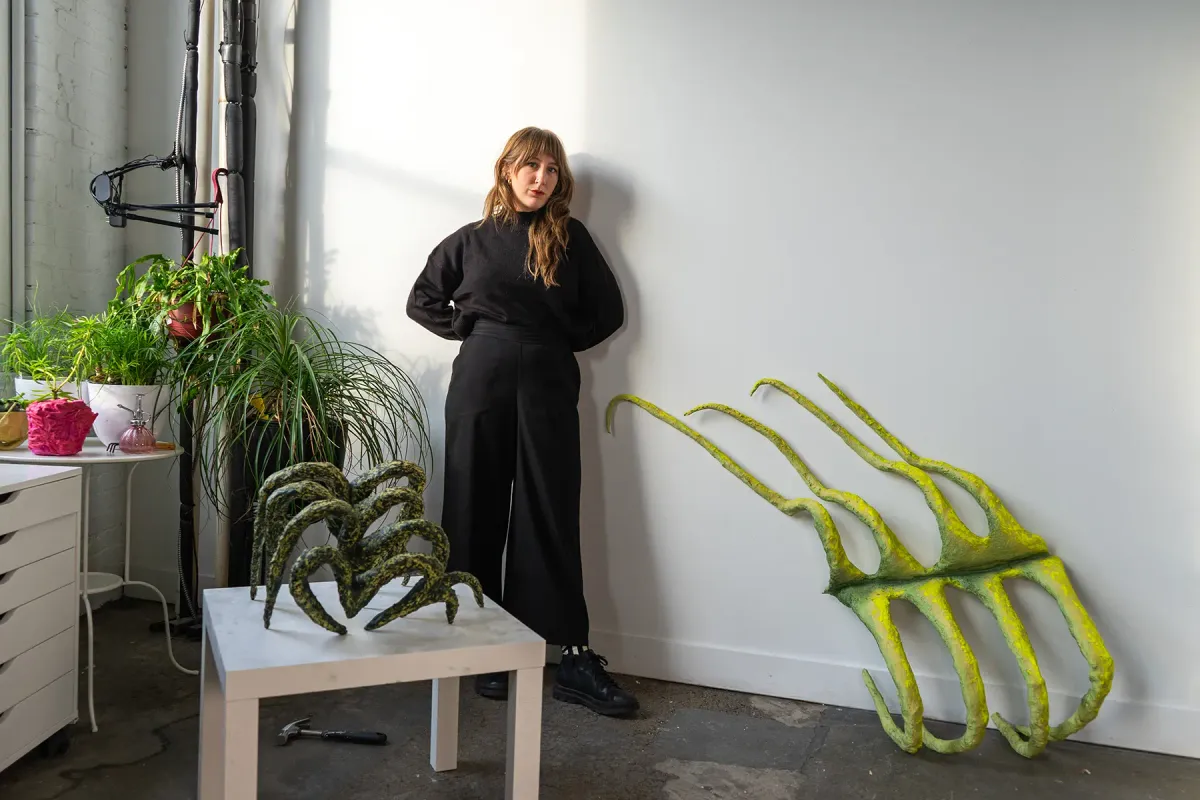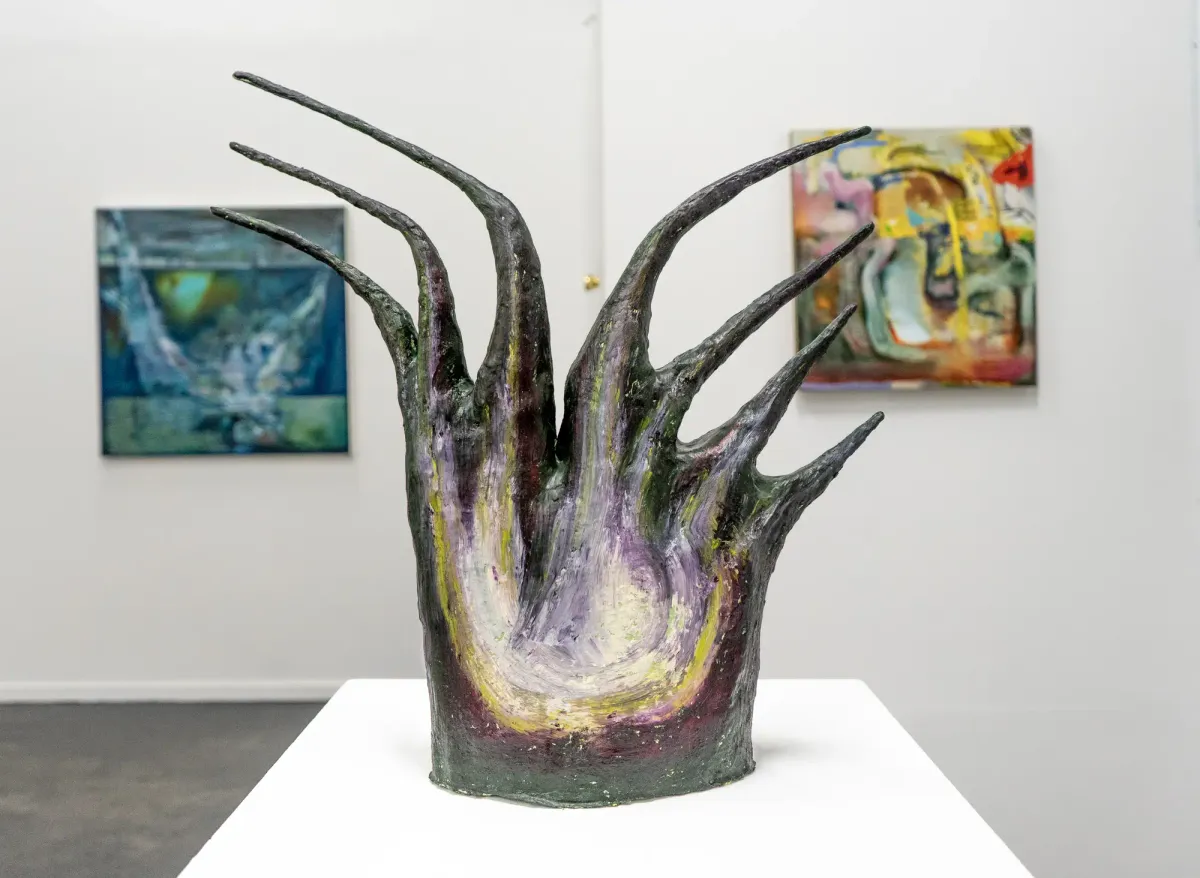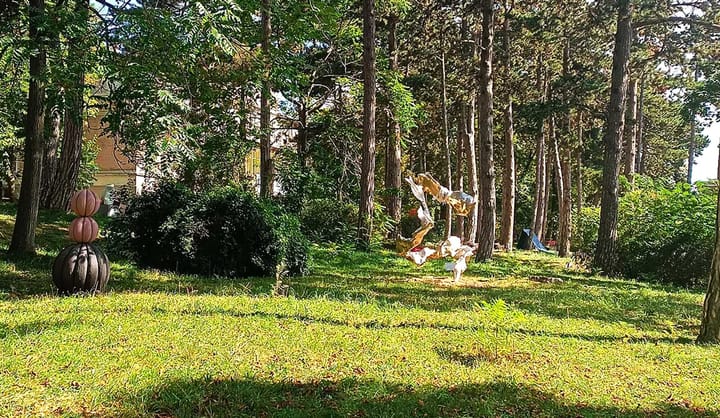Encounter the work of Philadelphia artists Matt Coombs and carrie R in a short, self-conducted interview during their exhibition “All Things Go” at Information Space.
All Things Go Exhibition with Carrie R and Matt Coombs
Three Questions and Three Answers: A Brief Inquiry about Illusion and Reality in Painting and Sculpture with Matt Coombs and Carrie R at Information Space in Philadelphia .
Nestled in an alley of garages resembling your classic DIY punk venue, where artist-run galleries, stray cats, and a wrestling gym converge, Information Space (Philadelphia, PA, USA) presents “All Things Go,” an arresting exhibition of work by Matt Coombs and carrie R.
Information’s curation portrays the transformative process of an idea, through Coombs’ abstract paintings that embody the elusive and ephemeral nature of thought and carrie R’s sculptures that serve as the solidified personification of thought.

Carrie R - Munchies Art Club Magazine
The exhibition is on view from October 26th through November 30th at 2024 E Westmoreland St., Philadelphia, PA.
Coombs and R conducted a short interview during the exhibition, prompting one another to ask and respond to three questions.
Three Questions for Matt from carrie
Carrie R: In our show, the landscape-object pairing between our work feels especially complementary. I observed that their presence together emphasizes our works' perceived and actual depths.
Several of your paintings have a strong inward pull or what feel like scenes behind a scene; an illusion that there is more yet to be found in the back, while my sculptures tend to push outward and forward. I’m curious how you feel about space and illusion in the images you’re creating.
Matt Coombs: I have always been fascinated with how oil paint can trick even the painter into seeing space and volume on a flat surface.
I end up believing it involuntarily, and it creates a conflict in my mind between rational and tactile sensibilities. A painting is also something of a sculpture. It is an object in the room. The concept of it being a window is another lie that can be believed involuntarily. So I’m interested in these contradictions.
Carrie R. and Matt Coombs Installation view (left) and detail (right) of “Soft Construction With Pork and Beans” by Matt Coombs. Images courtesy of the artists.
Years ago I started thinking about spaces that I do not have access to, and how that creates curiosity and projection. More recently I have been interested in the stakes of ambiguity. I have a kind of illiteracy of the natural world.
A river that is safe to drink from could look the same as one that is not. Which snakes are venomous? I’m interested in that split-second evaluation, and exposing myself and the viewer to that sensibility in a prolonged state.
Early in my painting life, I was taught in a representational, naturalistic style. The work I make now has a lot of that color sensitivity built in, so as to make even abstract forms and marks exist in a color framework that feels somewhat illusionary or naturalistic.
Carrie R. and Matt Coombs: Left: Installation view of “All Things Go.” Right: “Backyard Gum Graft” by Matt Coombs. Images courtesy of the artists
Carrie R:– There is nice movement throughout Daybell Hammock with interesting technical variations like dense areas of loose strokes, flattened smears, and sharp lines that break the scene. Would you share a little bit about some of the moves you made in this painting? Also, where does that title come from?
Matt Coombs: That painting went through several iterations before landing on that canvas. I had been using new tools and dragging paint across the canvas, then lightly dropping in these ghostly bursts of color.
I have a prism sticker on my studio window and I wanted to capture the sense of refracted light that makes a translucent rainbow of colors. A lot of the painting is redaction, I would remove paint and leave the remnant of what was there. Then paint back into it.
The painting’s title is a bit of a dark joke. I’m very interested in belief and illusions as I said previously. And I was taken in by this story of a religious author who convinced his romantic partner that everyone had been possessed by demons, and that the world was going to end.
Carrie R. and Matt Coombs Left: Installation view of “All Things Go.” Right: “Hand (Study)” by Matt Coombs. Images courtesy of the artists.
The beliefs had roots in a more mainstream religion. They committed horrible crimes and then they wanted to just go live in Hawaii. It cuts to this idea of being totally sincere and cynical at the same time. I wanted to make a painting that was a sort of hologram of a hammock; this desired place that doesn’t exist.
Carrie R: – Your work feels very layered and energized, but also very controlled, so I think you spend a lot of time with these individually, and I’m assuming they go through many phases and moods. What’s on your studio playlist during the course of a painting?
Matt Coombs: I work on many paintings at once, and I give them time to work on me. They let me know what they need. I follow certain rules based on the chemistry of the paint, and I do have a conception of what kind of painting I want to make. But I don't rigorously plan them out because I'm not interested in making a reproduction of a design.
Carrie R. and Matt Coombs Left: “Overexposed (Flower)” by Matt Coombs. Right: Installation view of “love freak, side step” by carrie R and “Overexposed (Flower)” by Matt Coombs. Images courtesy of the artists.
I usually start with loose washes on the white canvas, and then I use that exploration to dictate the rest of the painting. I find the imagery as I go along because my conditions for making a painting are much more visceral than they are symbolic or linguistic. Ironically though, I mostly listen to talk-based radio and podcasts in the studio. I had to keep music out of my work because it started to take over. I want to be as sensitive as possible to the painting itself, and I feel like having someone else’s art in my brain when I’m working splits my attention and sensitivities. Sometimes I can handle Delta Blues and big-band jazz. But nothing that transports me somewhere else.
Three Questions for carrie from Matt
Matt Coombs: – Your sculptures have a hand-made quality which contrasts the sleek abstract forms that first attract the viewer. What is the significance of your process, and how does that contrast the manufactured objects many people encounter daily?
Carrie R: I appreciate this observation and question because I have wondered if technology or advanced tools would help me achieve the forms in my mind better, or if they would take away from what makes the work unique. I’ll think, “The drama in that curve could be more slick if I 3D printed it from a digital model,” or, a limb turned out clunky because I expected too much of the materials and my hands got tired and sloppy.
Carrie R. and Matt Coombs: Installation view of “moonlit pandiculation” by carrie R. Installation view of “love freak, side step” by carrie R. Image courtesy of the artists | Image courtesy of the artists.
But usually, after I step away for a bit, I return to see them as dramatic and organic as I need them to be, and those “errors” I may have wanted to perfect with the precision of smarter tools keep the sculpture real. So it’s cool to hear that you see these as “sleek abstract forms.” I enjoy their surface effects–their “hand-made qualities” as you pointed out–which rely on the imperfect grooves and bumps of something built with hands. I work with a very, very loose plan, and I am unmeasured in my pigment mixtures, so working on such a whim certainly contrasts with a manufactured process. I won’t say I’ll never use the assistance of machines, but for now, I enjoy the simple sequence of pulling right from my brain to my hands. It is a total retreat from other areas of my life to be a kind of analog art practice.
Matt Coombs: – A lot of what comes through in your work is sensation itself: The life-like quality is muted by their stillness and their physicality as a “made” object. The viewer becomes more aware of themself as the living being in the room. How do you see this reciprocal transfer of sensation between the object and the viewer?
Carrie R: I want my sculptures to have an attractive drama. I’ve said this word a lot already, but it’s what I think about! I work towards this through combinations of curves and points, exaggerated appendages, multiple viewing points, requiring specific gravitational dependence or placement in the installation of the work, and vibrant colors (lately).
Carrie R. and Matt Coombs: Left: “thoracic sunset” by carrie R. Right: Installation view of “thoracic sunset” and “moonlit pandiculation” by carrie R. Images courtesy of the artists.
The cumulation of these characteristics seems to offer a level of perceived motion and activity. However, they are not kinetic sculptures, they are frozen in place, and I see them as moments depicting an experience or emotion.
If I wanted these to crawl across the room, I would build that machine into them. So for me, it’s about their balance in place and making the viewer the object in motion, moving around the sculptures to discover how their dimension offers different scenarios and to experience how they change along the way.
Matt Coombs: – Are you more of a fan of science fiction or fantasy?
Carrie R: My mind definitely hangs out in the realm of fantasy. I like things that don’t really make sense, and my mantra in the studio is “Can it get weirder?”
Science fiction is very cool, and there is a fairly common commentary from viewers that my work has a “creature-like” quality, so I can understand this wonder. But for me, it’s further on than that.
I don’t think about bugs or monsters, for example, and I don’t often make specific references to real life until I assign them a title at the end. I’m a fan of deep imagination and dreaming beyond what we know to be reality.
I think our imaginations are so powerful. Making art blows my mind all the time because we can just make anything.
It’s sort of bringing fantasy into reality. How amazing is that?
All Things Go - Exhibition Info and Venue
October 26 – November 30, 2024
Information Space
2024 E Westmoreland St
Philadelphia, PA, USA
Follow Carrie R and Matt Coombs on Instagram !






Comments ()